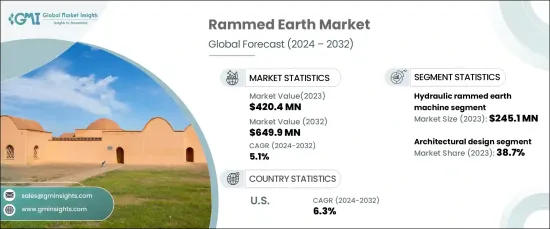
세계의 흙다짐 시장은 2023년에 4억 2,040만 달러로 평가되었으며, 2024년부터 2032년까지 연평균 복합 성장률(CAGR) 5.1%를 나타낼 것으로 예상됩니다.
이 성장의 원동력이 되는 것은 환경 문제에 대한 관심과 에너지 효율적인 건설의 필요성이 계속 증가하고 있기 때문에 지속 가능한 주택 솔루션에 대한 수요가 급증하고 있다는 것입니다. 흙다짐은 기존 건축자재를 대체하는 친환경 건축자재로 빠르게 인기를 끌고 있으며 환경 의식이 높은 건축업자와 주택 소유자에게 호소하고 있습니다. 환경 친화적인 건축 원칙에 자연스럽게 부합하기 때문에 지속 가능한 건축 분야에서 최선의 선택으로 자리 잡고 있습니다.

건설 업계에서는 저탄소에서 지속가능한 재료에 대한 주목이 높아지고 있으며, 이는 흙다짐의 채택에 박차를 가하고 있습니다. 생산과 운송에 상당한 에너지를 필요로 하는 콘크리트 및 강철과 같은 전통적인 재료와는 달리, 흙다짐은 환경 발자국이 상당히 낮다는 것을 자랑합니다. 이 재료는 현지에서 채취하는 토양, 모래, 점토, 자갈로 만들어지므로 가공이 최소화되고 에너지 효율도 높습니다. 환경 친화적이고 비용 효율적이기 때문에 현대 건설에 이상적인 선택입니다.
| 시장 범위 | |
|---|---|
| 시작연도 | 2023년 |
| 예측연도 | 2024년-2032년 |
| 시작금액 | 4억 2,040만 달러 |
| 예측 금액 | 6억 4,990만 달러 |
| CAGR | 5.1% |
흙다짐 시장은 프로젝트 유형별로 소규모, 중규모 및 대규모 프로젝트로 구분됩니다. 대규모 프로젝트 부문은 2023년에 시장을 독점하여 1억 6,910만 달러를 창출했고, 2032년까지 연평균 복합 성장률(CAGR) 5.3%로 성장할 것으로 예측됩니다. 이 부문에는 집단 주택, 시설 건축물, 대규모 상업 개발 등이 포함되며, 모두 고급 엔지니어링, 열 모델링, 엄청난 재정 투자가 필요합니다.
용도별로 시장은 주택 건설, 상업 건설, 건축 설계, 도시 개발로 나뉩니다. 이 중 건축 설계 분야는 2023년 시장 점유율의 38.7%를 차지했으며, 2032년까지의 CAGR은 5.6%의 성장률을 기록할 것으로 예상됩니다. 건축 프로젝트에서 지속가능성, 에너지 효율, 미관을 중시하는 경향이 강해지고 있는 것이, 디자인 중시의 건축에 바람직한 재료로서 흙다짐을 채용하는 원동력이 되고 있습니다.
미국의 흙다짐 시장은 2023년에 75.7%라는 경이적인 시장 점유율을 차지했으며, 2024년부터 2032년까지 연평균 복합 성장률(CAGR)6.2%의 성장률을 기록할 것으로 예상됩니다. 이러한 성장은 국가의 지속가능성에 대한 강한 헌신, 지속적인 기술 진보, 유리한 정부 규정에 의해 추진되고 있습니다. 환경 친화적이고 에너지 효율적인 주택에 대한 수요가 증가함에 따라 흙다짐은 미국에서 유력한 건설 재료로서의 지위를 확립하고 있습니다.
The Global Rammed Earth Market was valued at USD 420.4 million in 2023 and is projected to grow at a CAGR of 5.1% from 2024 to 2032. This growth is driven by the surging demand for sustainable housing solutions, as environmental concerns and the need for energy-efficient construction continue to rise. Rammed earth is rapidly gaining popularity as a green alternative to traditional building materials, appealing to environmentally conscious builders and homeowners alike. Its natural alignment with eco-friendly building principles positions it as a top choice in the sustainable construction sector.

The construction industry's increasing focus on low-carbon, sustainable materials is fueling the adoption of rammed earth. Unlike conventional materials such as concrete and steel-which require significant energy for production and transportation-rammed earth boasts a substantially lower environmental footprint. This material is made from locally sourced soil, sand, clay, and gravel, requiring minimal processing and offering high energy efficiency. Its eco-friendly and cost-effective attributes make it an ideal choice for modern construction.
| Market Scope | |
|---|---|
| Start Year | 2023 |
| Forecast Year | 2024-2032 |
| Start Value | $420.4 Million |
| Forecast Value | $649.9 Million |
| CAGR | 5.1% |
The rammed earth market is segmented by project type into small, medium, and large-scale projects. The large project segment dominated the market in 2023, generating USD 169.1 million, and is expected to grow at a CAGR of 5.3% through 2032. This segment includes multi-unit residential buildings, institutional structures, and large commercial developments, all of which demand advanced engineering, thermal modeling, and substantial financial investment.
By application, the market is divided into residential construction, commercial construction, architectural design, and urban development. Among these, the architectural design segment accounted for 38.7% of the market share in 2023 and is anticipated to grow at a CAGR of 5.6% through 2032. Increasing emphasis on sustainability, energy efficiency, and aesthetic appeal in architectural projects is driving the adoption of rammed earth as a preferred material in design-focused constructions.
The U.S. rammed earth market is set to dominate globally, holding an impressive 75.7% market share in 2023 and projected to grow at a CAGR of 6.2% from 2024 to 2032. This growth is propelled by the nation's strong commitment to sustainability, ongoing technological advancements, and favorable government regulations. As the demand for eco-friendly, energy-efficient homes escalates, rammed earth continues to establish itself as a go-to construction material in the U.S.